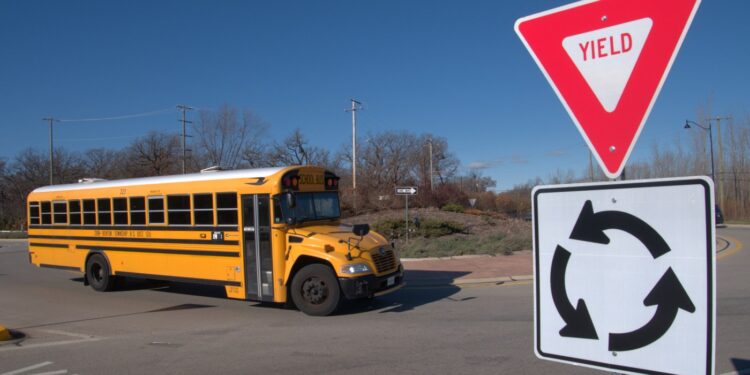
Lake County is looking for feedback on a proposed roundabout at Hunt Club and Stearns School roads in Warren Township as it moves to double the number of roundabout intersections within its system in the coming years.
While it won’t be the first roundabout in Lake County, the new intersection would be its first multi-lane roundabout. The $15 million project, which includes drainage improvements and a bike path, is planned to be finished in 2027.
Since the 1990s, roundabouts have swept across the United States, boasting better safety records than more traditional intersections. Despite their relatively new arrival in America, they’re far from a new invention; a 1995 edition of Public Roads, the self-described “premier quarterly magazine of the Federal Highway Administration,” detailed the rise of the roundabout in America after decades of use in the United Kingdom.
The first modern “yield-at-entry” roundabout was built in 1956 in the UK according to the FHWA, although designs can be traced back centuries to designs in the late 1800s from both French and American architects. Modern American roundabouts arrived in the U.S. in 1990 in Las Vegas.
Lake County’s first roundabout was built in 2010, according to county assistant engineer Kevin Carrier, at Riverwoods and Everett roads in the village of Mettawa. There are about nine currently in the system, with two planned to begin construction next year on Darrell Road in the Wauconda Township, and many more over the coming years, bringing the total up to 18-20, Carrier said.
Julian Rozwadowski, project manager for the Hunt Club and Stern School roads project, said the Lake County Division of Transportation looks for intersections that need improvements, focusing on safety and operations. The vast majority of crashes at the intersection have been rear-end collisions, about 74%, which Rozwadowski said indicates issues with capacity.
After looking into an array of potential designs, including several signaled and roundabout intersections, the multi-lane roundabout was determined to be the best option.
Roundabouts aren’t a “one-size-fits-all” solution for every intersection, but “all things equal, they have some good benefits, like safety and operation,” Carrier said.
Rozwadowski explained that in a regular intersection of two four-lane roads, there are 52 “conflict points,” or locations where multiple traffic paths intersect and cars can collide. Thirty-six of those are called “crossing conflict points,” which can lead to the most severe and injury-prone crashes.
In comparison, the proposed roundabout has a total of 24 points, with just eight crossing conflict points.
While it’s been more than 30 years since roundabouts came to the U.S., Illinois was a little slower to develop them. Carrier said he’s heard stories about the resistance they faced when the first roundabout was installed in Lincolnshire. Times have changed, however, he said.
“There was a lot of opposition, and people just weren’t sold on it. If you talk to people down there today, they love it,” Carrier said. “People definitely see the benefits.”
The Illinois Department of Transportation is also looking to implement roundabouts across the state.
“I think Illinois is coming around on them, no pun intended,” Carrier said.
Today, the primary concern from people is education, Carrier said. Do drivers understand how to properly navigate a roundabout? Rozwadowski said that concern has especially cropped up with the new proposal being multi-lane, but county officials have plans to address the issue.
“We’re working on a very robust public education campaign, whether it be ahead of time, so people go into it knowing, or that ‘in-the-moment’ education when you get to the roundabout,” he said.
Originally Published:






